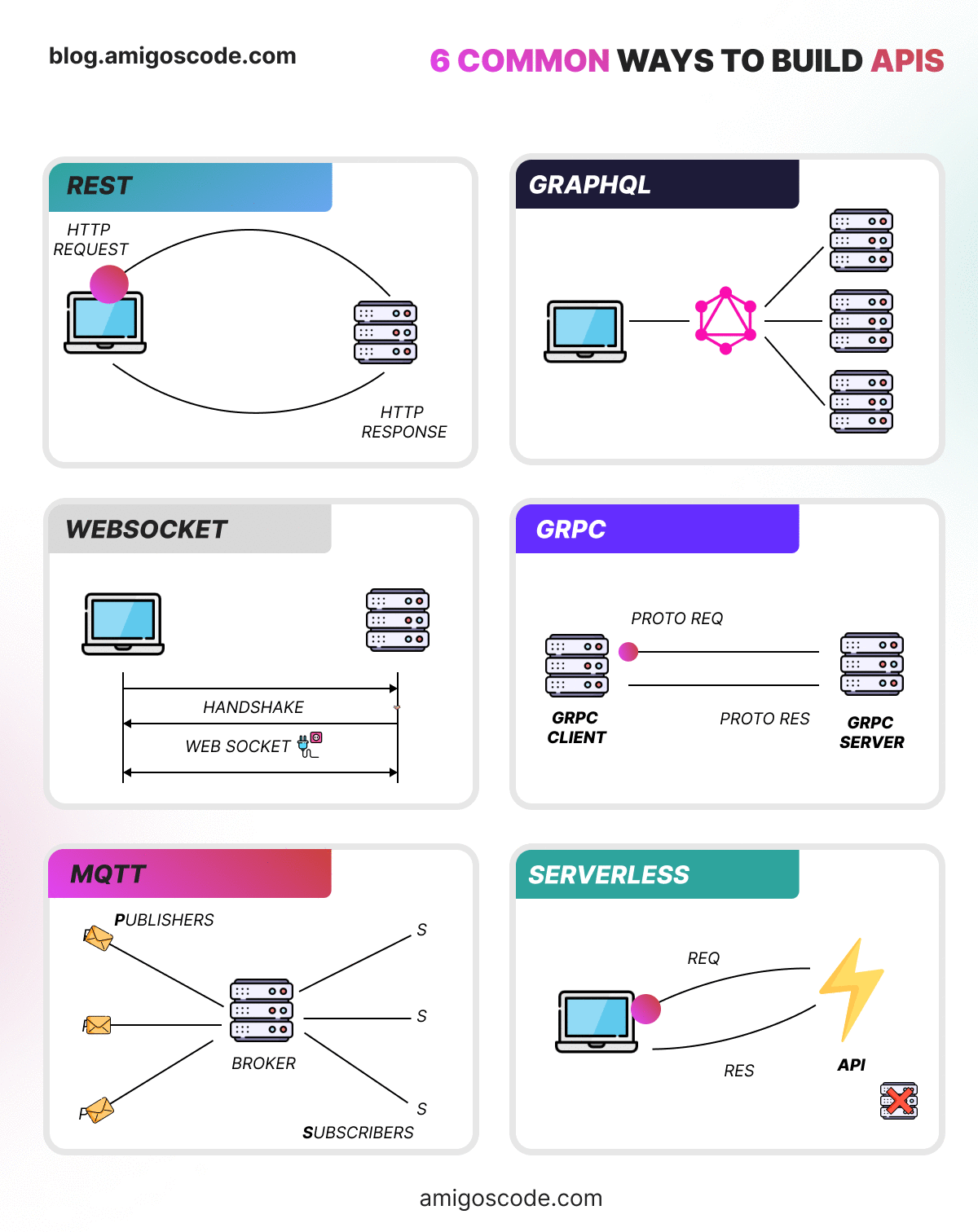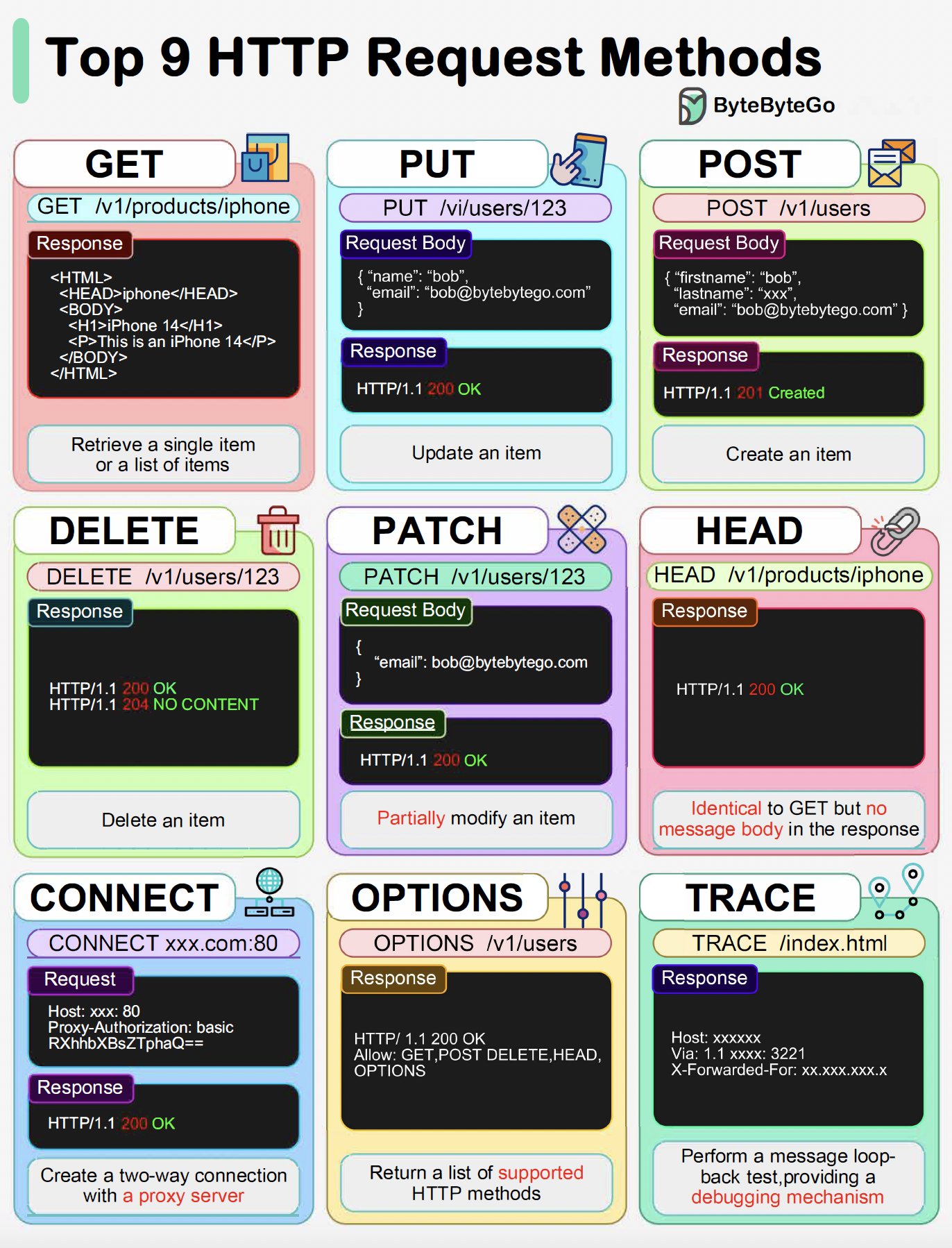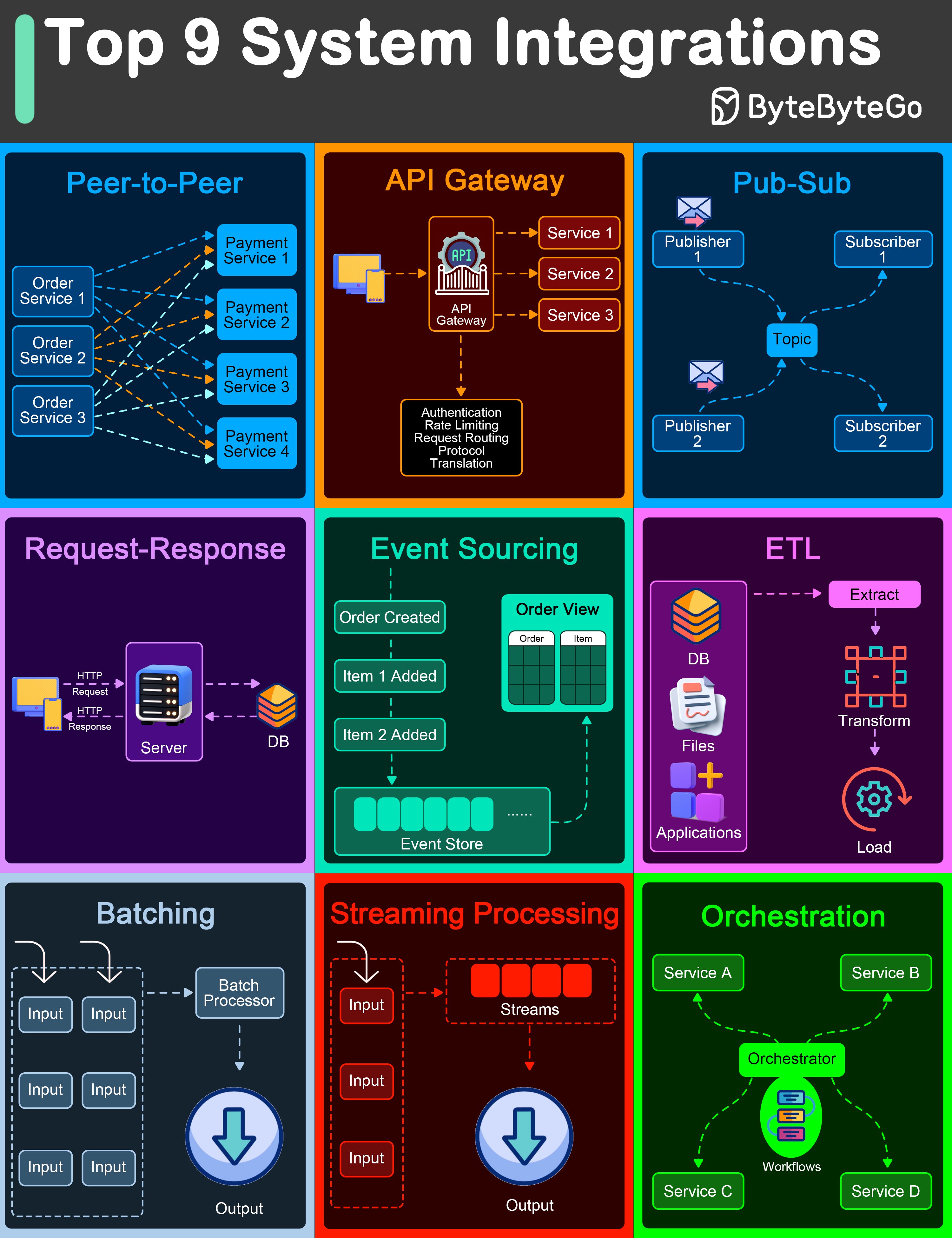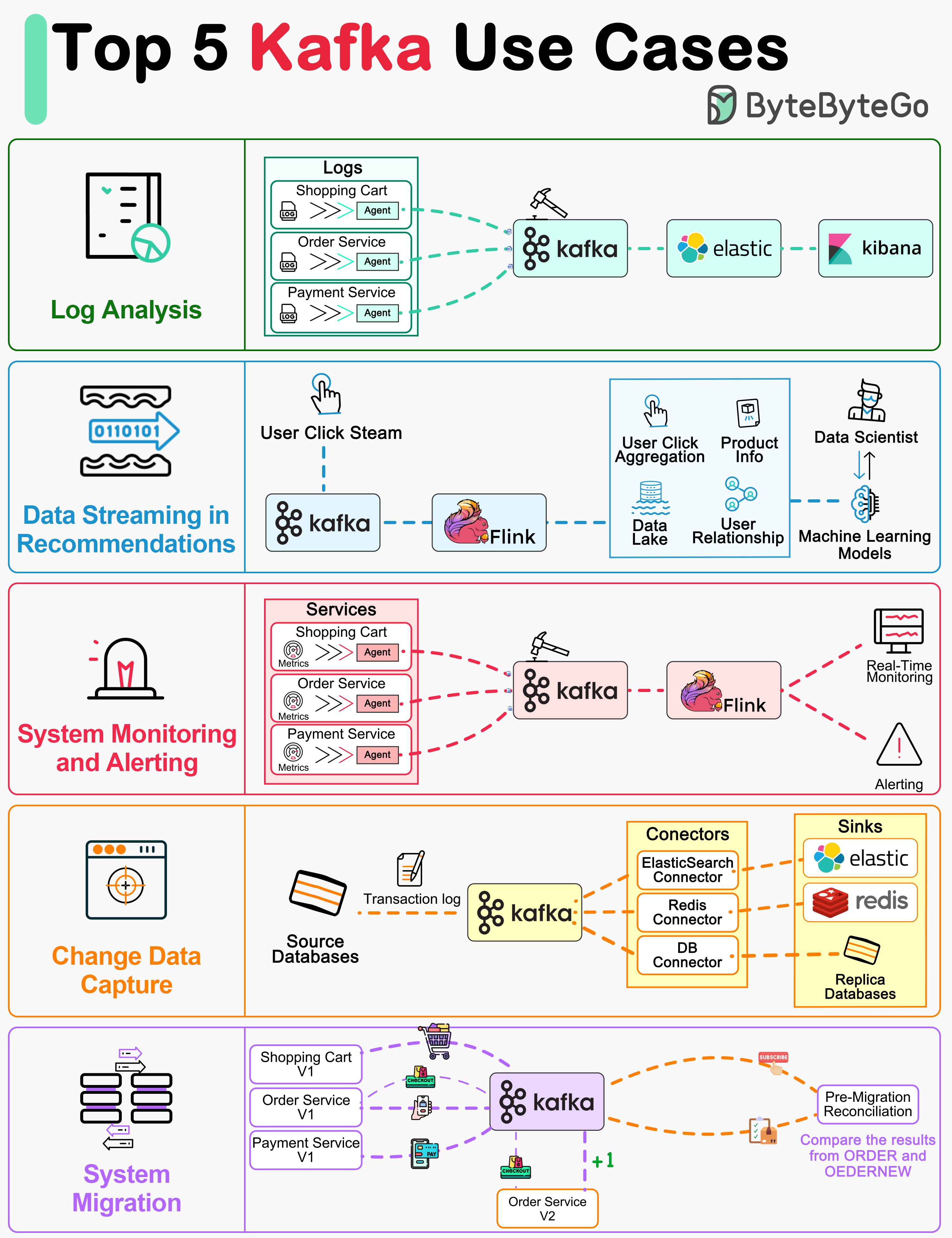Kafka 101
Top 9 HTTP Request Methods
1. HTTP GET This retrieves a resource from the server. It is idempotent. Multiple identical requests return the same result. '
2. HTTP PUT This updates or Creates a resource. It is idempotent. Multiple identical requests will update the same resource.
3. HTTP POST This is used to create new resources. It is not idempotent, making two identical POST will duplicate the resource creation.
4. HTTP DELETE This is used to delete a resource. It is idempotent. Multiple identical requests will delete the same resource.
5. HTTP PATCH The PATCH method applies partial modifications to a resource.
6. HTTP HEAD The HEAD method asks for a response identical to a GET request but without the response body.
7. HTTP CONNECT The CONNECT method establishes a tunnel to the server identified by the target resource.
8. HTTP OPTIONS This describes the communication options for the target resource.
9. HTTP TRACE This performs a message loop-back test along the path to the target resource.
Top 9 System Integrations
Top 5 Kafka Use Cases
Kafka was originally built for massive log processing. It retains messages until expiration and lets consumers pull messages at their own pace. Let’s review the popular Kafka use cases.
- Log processing and analysis
- Data streaming in recommendations
- System monitoring and alerting
- CDC (Change data capture)
- System migration
What does API Gateway Do?
Step 1 – The client sends an HTTP request to the API gateway.
Step 2 – The API gateway parses and validates the attributes in the HTTP request.
Step 3 – The API gateway performs allow-list/deny-list checks.
Step 4 – The API gateway talks to an identity provider for authentication and authorization.
Step 5 – The rate limiting rules are applied to the request. If it is over the limit, the request is rejected.
Steps 6 and 7 – Now that the request has passed basic checks, the API gateway finds the relevant service to route to by path matching.
Step 8 – The API gateway transforms the request into the appropriate protocol and sends it to backend microservices.
Steps 9-12: The API gateway can handle errors properly, and deals with faults if the error takes a longer time to recover (circuit break). It can also leverage ELK (Elastic-Logstash-Kibana) stack for logging and monitoring. We sometimes cache data in the API gateway.
Over to you: 1) What’s the difference between a load balancer and an API gateway? 2) Do we need to use different API gateways for PC, mobile and browser separately?
Database Sharding
18 Most Used Java List Methods

- 1. add(E element) – Adds the specified element to the end of the list.
- 2. addAll(Collection<? extends E> c) – Adds all elements of the specified collection to the end of the list.
- 3. remove(Object o) – Removes the first occurrence of the specified element from the list.
- 4. remove(int index) – Removes the element at the specified position in the list.
- 5. get(int index) – Returns the element at the specified position in the list.
- 6. set(int index, E element) – Replaces the element at the specified position in the list with the specified element.
- 7. indexOf(Object o) – Returns the index of the first occurrence of the specified element in the list.
- 8. contains(Object o) – Returns true if the list contains the specified element.
- 9. size() – Returns the number of elements in the list.
- 10. isEmpty() – Returns true if the list contains no elements.
- 11. clear() – Removes all elements from the list.
- 12. toArray() – Returns an array containing all the elements in the list.
- 13. subList(int fromIndex, int toIndex) – Returns a view of the portion of the list between the specified fromIndex, inclusive, and toIndex, exclusive.
- 14. addAll(int index, Collection<? extends E> c) – Inserts all elements of the specified collection into the list, starting at the specified position.
- 15. iterator() – Returns an iterator over the elements in the list.
- 16. sort(Comparator<? super E> c) – Sorts the elements of the list according to the specified comparator.
- 17. replaceAll(UnaryOperator operator) – Replaces each element of the list with the result of applying the given operator.
- 18. forEach(Consumer<? super E> action) – Performs the given action for each element of the list until all elements have been processed or the action throws an exception.
6 Common Ways To Publish APIs

First let me explain what is an API in simple terms
Imagine you're a customer (an application or program) sitting at a table (a device), and you want to order food (request data or services). Instead of going into the kitchen (the system or server) yourself, you interact with the waiter (API), who takes your order and communicates it to the kitchen on your behalf. The kitchen then prepares the food (performs the requested task), and the waiter brings it back to you.
Similarly, an API allows different software applications to communicate and share information or perform specific tasks without knowing the intricate details of each other's internal workings. It acts as a bridge, enabling applications to request and exchange data or functionalities in a standardized way.
Ok now lets explore 6 common ways to build APIs.
REST: Architecture using standard HTTP methods for CRUD operations on resources.
GraphQL: Query language enabling clients to request specific data structures.
WebSocket: Full-duplex communication protocol for real-time applications.
gRPC: High-performance RPC framework for efficient communication between services.
MQTT: Lightweight messaging protocol for low-bandwidth, high-latency networks, common in IoT.
Serverless: Cloud computing model where developers focus on code, and the provider manages infrastructure.
5 Java Testing Frameworks YOU SHOULD KNOW

JUnit
As one of the most widely used frameworks, JUnit is synonymous with unit testing in the Java realm. Its simplicity and user-friendliness make it an indispensable tool for developers. Its seamless integration with IDEs and build tools enables continuous feedback on the code's health.
TestNG
TestNG extends beyond unit tests to cover a wider range of testing needs, including integration, functional, and end-to-end tests. Its flexibility and scalability cater to both simple scenarios and complex testing environments.
Selenium
When it comes to automation for web applications, Selenium stands tall. Its ability to simulate user interactions in web browsers across platforms is unparalleled. Its compatibility with JUnit and TestNG harnesses the strengths of these frameworks for comprehensive web testing.
Cucumber
Involving non-technical stakeholders in the development process is crucial, and Cucumber's Behavior-driven development (BDD) approach bridges this gap. It allows the description of software behaviors in plain language, ensuring everyone's understanding and contribution.
Mockito
Unit tests require isolation, and Mockito excels in mocking dependencies, allowing tests to focus on the code under test. It's a powerful ally in maintaining clean test code and offers seamless integration with JUnit and TestNG.






